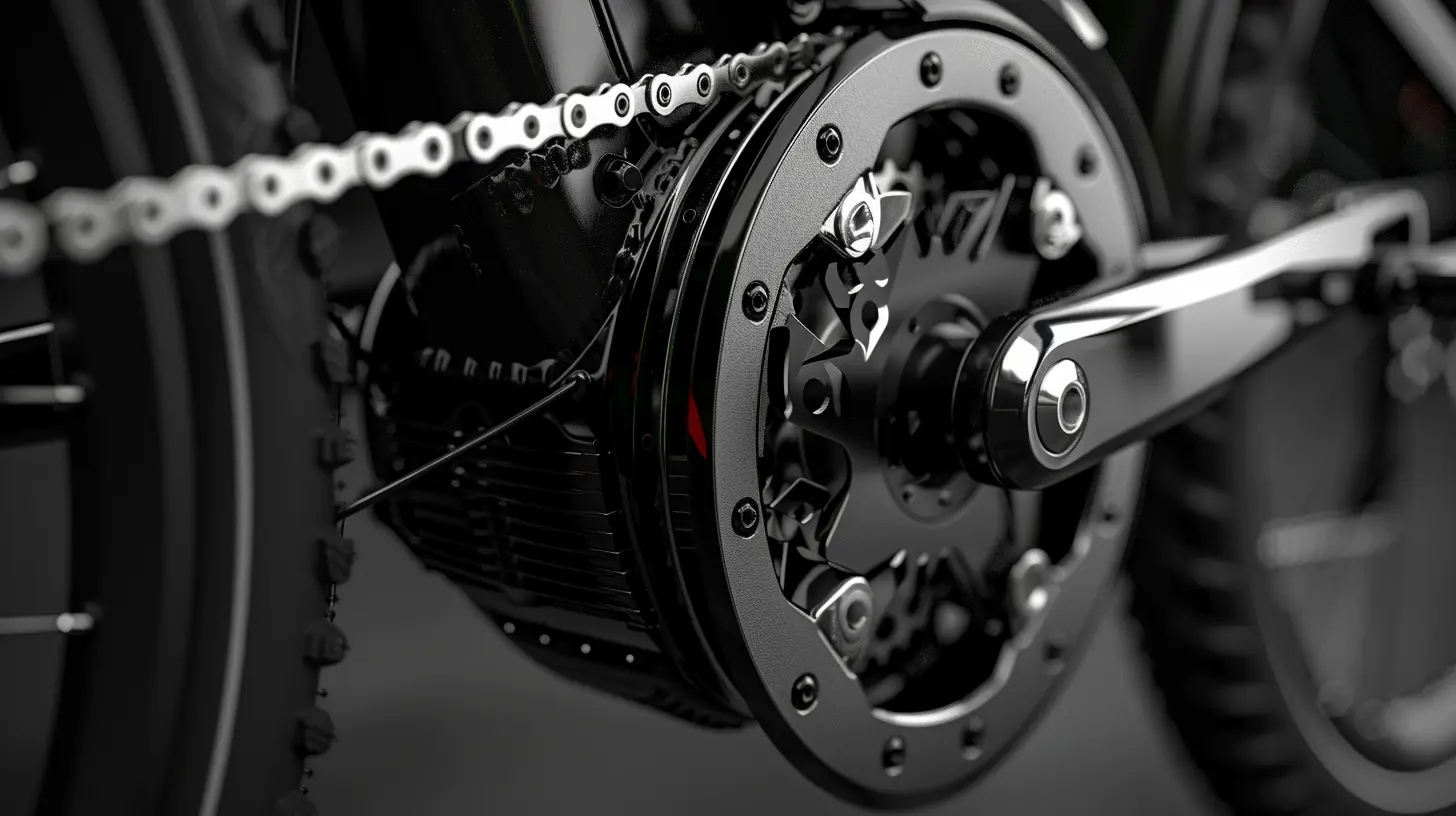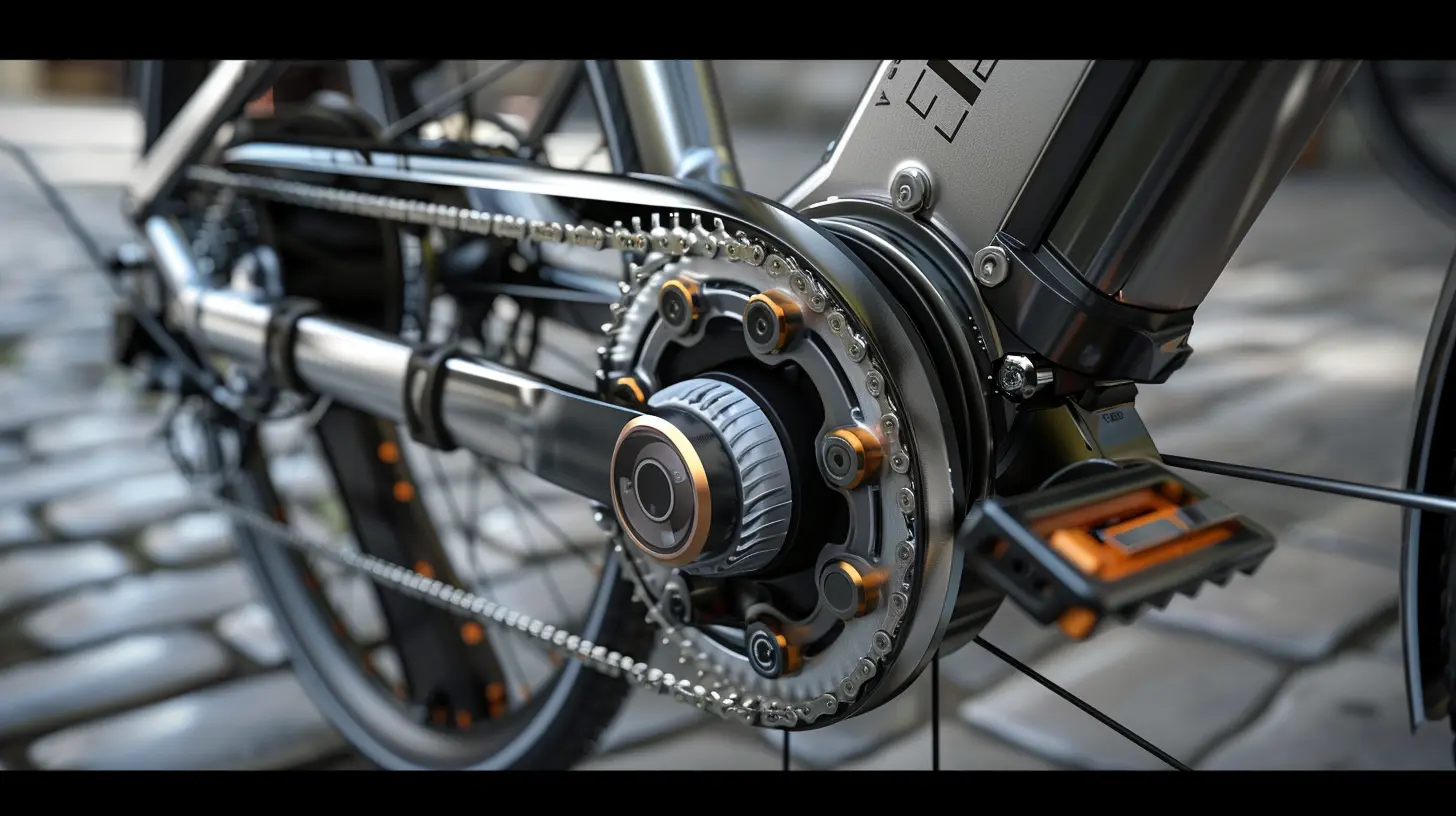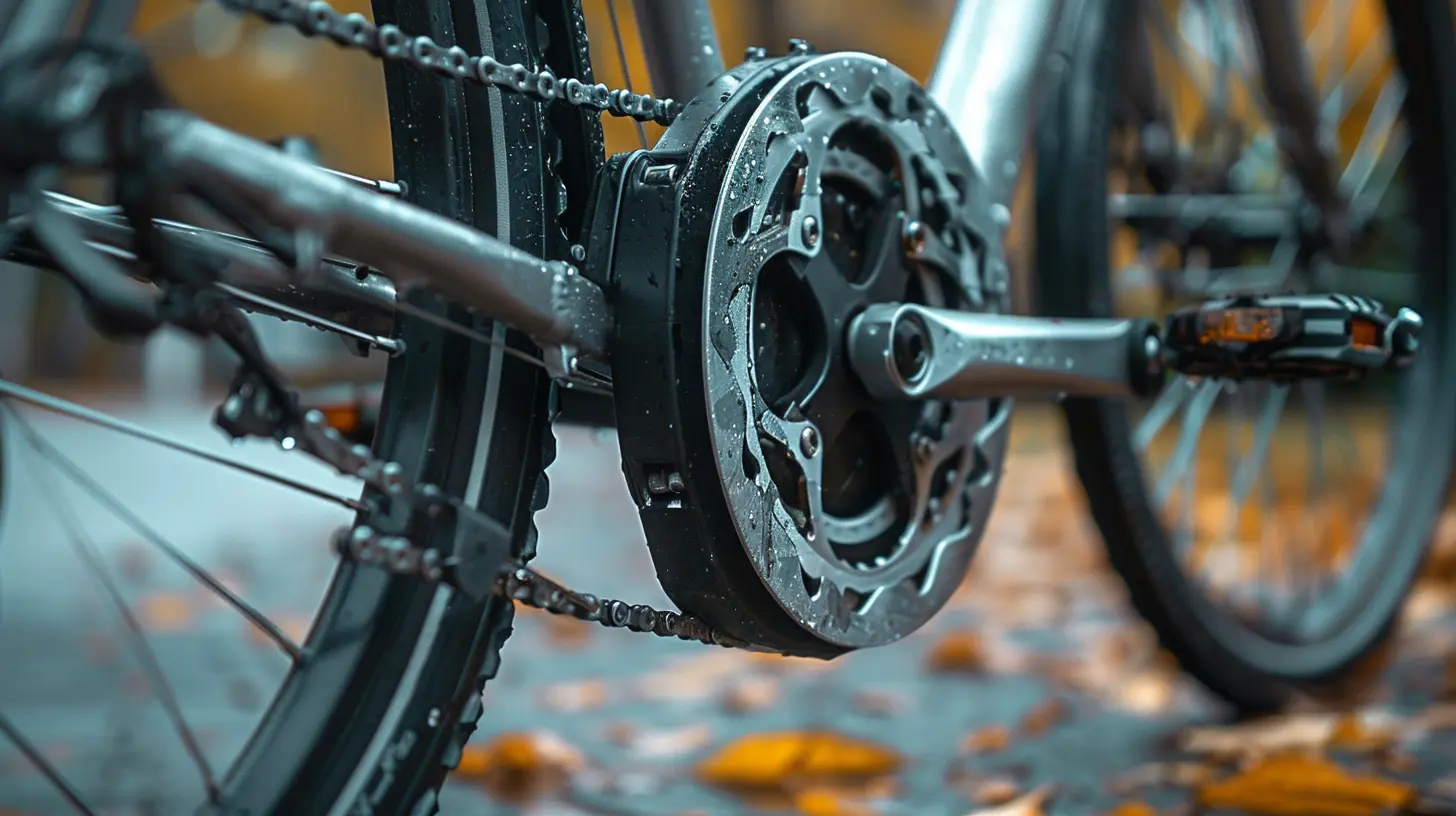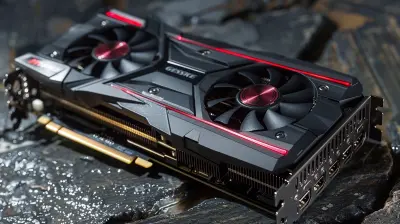Exploring the Differences Between Hub-Drive and Mid-Drive E-Bikes
3 January 2025
E-bikes are no longer just a trend; they’re rapidly becoming a practical solution for commuters, adventurers, and casual riders alike. But if you're in the market for an e-bike, you’ve probably encountered a pretty crucial question: Should you go for a hub-drive or a mid-drive e-bike?
These two terms refer to the location of the motor on the e-bike and, believe it or not, this tiny detail can drastically change your riding experience. So, which one is right for you? In this article, we’ll break down the differences between hub-drive and mid-drive e-bikes, discussing their pros and cons to help you make an informed decision.
Let’s dive in!

What Is a Hub-Drive E-Bike?
A hub-drive e-bike features a motor located in the hub of either the front or rear wheel. The motor directly powers the wheel, helping to propel you forward. These systems are typically easier to install and maintain, making them a favorite among budget-conscious riders.How Does It Work?
In a hub-drive setup, the motor is separate from the bike’s drivetrain (the chain, cranks, and gears). When you engage the throttle or pedal-assist, the motor spins the wheel independently of your pedaling force. In simpler terms, the motor does the work while your legs get a bit of a break.Key Features of Hub-Drive Motors
- Location: Either front or rear wheel hub.- Motor Type: Direct-drive or geared motor.
- Power Delivery: Independent of pedaling effort.
- Ride Feel: More like a "pushing" or "pulling" sensation depending on whether the motor is in the rear or front hub.

What Is a Mid-Drive E-Bike?
A mid-drive e-bike, on the other hand, has its motor located at the bike’s bottom bracket, right between the two pedals. Here, the motor is integrated into the bike’s drivetrain and works in harmony with the gears.How Does It Work?
In a mid-drive system, the motor assists your pedaling by driving power through the bike’s chain and gears. This setup allows the motor to amplify the torque, making it easier to climb steep hills or navigate rough terrain. Unlike hub-drive, your pedaling effort and the motor's power are intertwined.Key Features of Mid-Drive Motors
- Location: Bottom bracket (between the pedals).- Motor Type: Centralized motor.
- Power Delivery: Amplifies your pedaling force.
- Ride Feel: Feels more natural and responsive, like a turbocharged version of your own effort.

Pros and Cons of Hub-Drive E-Bikes
Both motor systems have their strengths and weaknesses, and hub-drive e-bikes are no different. Let’s take a closer look at the pros and cons of hub-drive motors.Pros of Hub-Drive E-Bikes
1. Simplicity and Cost-Effectiveness
Hub-drive motors are generally less complicated than mid-drive systems. They have fewer moving parts, making them a cost-effective choice. If you're on a budget or just getting into the world of e-bikes, a hub-drive motor can be a great starting point.2. Lower Maintenance
Because the motor is separate from the bike’s drivetrain, it doesn’t put added strain on the chain or gears. This means fewer maintenance headaches down the road.3. Smooth Power Delivery
Hub-drive systems typically provide a smoother, more consistent power output. Since they’re not tied to your pedaling, they offer an effortless riding experience, especially on flat terrain.4. Easier Installation
If you’re converting a traditional bike into an e-bike, hub-drive kits are often easier to install. They don’t require modifications to the bike’s frame or drivetrain.Cons of Hub-Drive E-Bikes
1. Less Efficient on Hills
Hub-drive motors can struggle on steep inclines. Since they don’t work with your gears, they don’t deliver the same torque as mid-drive motors. This means you’ll likely have to work harder when going uphill.2. Heavier Wheel
Since the motor is located in either the front or rear hub, it adds weight to the wheel. This can make the bike feel less balanced and harder to maneuver, especially at lower speeds.3. Less Natural Feel
Some riders find that the power delivery of hub-drive systems feels less natural. Since the motor is separate from your pedaling, it can feel like the bike is doing all the work for you, which can take away from the joy of riding.
Pros and Cons of Mid-Drive E-Bikes
Mid-drive e-bikes tend to be more expensive, but they also come with a range of benefits that could make them worth the investment. Let’s explore the pros and cons of mid-drive motors.Pros of Mid-Drive E-Bikes
1. Better for Hills and Rough Terrain
Mid-drive motors shine when it comes to challenging terrain. Because the motor works with your gears, it can adjust to different riding conditions, making it easier to tackle steep hills and off-road trails.2. More Efficient Power Delivery
Mid-drive systems use the bike’s gears to deliver power more efficiently. This means you’ll get more range out of your battery, especially when riding on varied terrain.3. More Balanced Weight Distribution
With the motor located at the bike’s center, mid-drive systems offer better weight distribution. This makes the bike feel more stable and easier to control, particularly when navigating tight turns or tricky trails.4. Natural Pedaling Feel
Many riders prefer the feel of a mid-drive motor because it amplifies their own pedaling effort. It feels like you’re riding a regular bike, but with superhuman strength!Cons of Mid-Drive E-Bikes
1. Higher Cost
Mid-drive systems are more complex and therefore more expensive. If you’re on a tight budget, the cost of a mid-drive e-bike might be a dealbreaker.2. Increased Strain on Drivetrain
Because the motor works with the bike’s chain and gears, it can put added strain on these components. This means you may need to replace your chain or cassette more frequently than you would on a hub-drive bike.3. Requires More Maintenance
Mid-drive motors are integrated with the bike’s drivetrain, so they require more maintenance. If something goes wrong, repairs can be more complicated and costly compared to hub-drive systems.Performance Comparison: Hub-Drive vs Mid-Drive
Now that we’ve covered the basics, how do hub-drive and mid-drive e-bikes stack up against each other in real-world scenarios? Let’s dive into some specific performance categories to see how they compare.1. Hill Climbing
- Mid-Drive: Clear winner. Mid-drive motors provide better torque and use the bike's gears to tackle steep hills effortlessly.- Hub-Drive: Falls short. Hub-drive motors tend to struggle on inclines, especially without a throttle boost.
2. Battery Efficiency
- Mid-Drive: More efficient. Since mid-drive motors work with your gears, they can be more energy-efficient, giving you more range per charge.- Hub-Drive: Less efficient. Hub-drive systems tend to use more battery power on varying terrain, especially when tackling hills.
3. Weight Distribution
- Mid-Drive: Superior balance. The motor is centralized, offering better weight distribution and improved handling.- Hub-Drive: Unbalanced. The motor’s weight in the wheel can make the bike feel lopsided, especially when maneuvering at low speeds.
4. Maintenance and Durability
- Mid-Drive: Higher maintenance. The motor puts additional wear and tear on the drivetrain components.- Hub-Drive: Lower maintenance. Since the motor is separate from the drivetrain, it's easier to maintain in the long run.
5. Cost
- Mid-Drive: More expensive. The added complexity and performance benefits come at a higher price point.- Hub-Drive: More affordable. If you’re on a budget, hub-drive e-bikes are generally easier on the wallet.
Which One Should You Choose?
So, which is better: hub-drive or mid-drive? Well, it depends on your riding style and priorities.- If you’re a commuter who rides mostly on flat terrain and wants a low-maintenance, affordable option, a hub-drive e-bike could be the way to go.
- If you’re an adventurer who loves hitting the trails or climbing hills, and you don’t mind spending a bit more for that extra torque and efficiency, a mid-drive e-bike might be your perfect match.
At the end of the day, both systems have their merits, and the best choice depends on how and where you’ll be riding. What’s important is that you choose an e-bike that fits your lifestyle and makes your rides more enjoyable.
Conclusion
To sum it all up, the choice between a hub-drive and mid-drive e-bike comes down to your personal preferences and riding needs. Hub-drive motors are simple, affordable, and great for flat terrain, while mid-drive motors offer better performance on hills, more efficient power delivery, and a more natural riding feel.Whichever you choose, both systems can enhance your cycling experience, making it easier, faster, and more fun to get out there on two wheels. So, what's it going to be: hub-drive or mid-drive? The choice is yours!
all images in this post were generated using AI tools
Category:
Electric BicyclesAuthor:

Marcus Gray
Discussion
rate this article
21 comments
Dana Barnes
Great insights! Understanding e-bike choices is essential.
February 25, 2025 at 12:49 PM

Marcus Gray
Thank you! I'm glad you found the insights helpful. Understanding these differences can really enhance the e-bike experience!
Brandon Cummings
Great overview! Understanding the pros and cons of hub-drive versus mid-drive e-bikes helps consumers make informed decisions. Excited to see how this impacts future e-bike designs!
February 14, 2025 at 8:34 PM

Marcus Gray
Thank you! I'm glad you found the overview helpful. It will be interesting to see how these insights shape future e-bike innovations!
Jane Long
This article offers a concise comparison between hub-drive and mid-drive e-bikes, highlighting their unique advantages. Hub-drive models provide simplicity and ease of use, while mid-drive systems excel in performance and hill-climbing ability. Understanding these distinctions helps consumers make informed decisions based on their riding preferences and needs.
February 2, 2025 at 5:11 AM

Marcus Gray
Thank you for your thoughtful comment! I'm glad you found the article helpful in understanding the key differences between hub-drive and mid-drive e-bikes. Your insights on their advantages are spot on!
Jane McMaster
This article provides a concise overview of the key differences between hub-drive and mid-drive e-bikes. Each system has unique benefits, influencing performance, maintenance, and riding experience. Understanding these distinctions will help potential buyers make informed choices tailored to their needs.
January 26, 2025 at 12:51 PM

Marcus Gray
Thank you for your feedback! I'm glad you found the overview helpful in understanding the key differences between hub-drive and mid-drive e-bikes. Your insights on performance and maintenance are spot on!
Remington McSweeney
Great article! Understanding the differences between hub-drive and mid-drive e-bikes helps consumers make informed choices. Well explained!
January 20, 2025 at 7:54 PM

Marcus Gray
Thank you for your kind words! I'm glad you found the article helpful in making informed choices.
Hunter Duke
Choosing between hub-drive and mid-drive? It's like picking between a donut and a cronut—tough but tasty!
January 17, 2025 at 7:45 PM

Marcus Gray
Great analogy! Both have unique benefits just like donuts and cronuts—it's all about what suits your ride style best!
Bennett McNair
In the dance of wheels, hub and mid collide, Each with its grace, where tech and ride abide. Choose your path—power’s pulse, or harmony's glide, Adventure awaits on electric tide.
January 15, 2025 at 11:25 AM

Marcus Gray
Thank you for your poetic insights! You've beautifully captured the essence of hub and mid-drive e-bikes. Each offers unique advantages, enhancing the adventure of cycling.
Kimberly Palmer
Great overview of hub-drive and mid-drive e-bikes! I appreciate how you highlighted the pros and cons of each system. It's crucial for potential buyers to understand these differences to make informed choices. Thank you for sharing this valuable information!
January 12, 2025 at 3:37 AM

Marcus Gray
Thank you for your kind words! I'm glad you found the overview helpful in making informed choices about e-bikes. Happy riding!
Tenley Meyers
Choosing between hub-drive and mid-drive e-bikes is like picking between a comfy couch and a sleek sports car—both have their winning traits!
January 11, 2025 at 8:59 PM

Marcus Gray
Great analogy! Both types offer unique benefits, catering to different riding styles and preferences.
Riff Rocha
Great overview of hub-drive and mid-drive e-bikes! It's helpful to understand their unique benefits. This will definitely help readers make informed choices. Thanks!
January 10, 2025 at 7:19 PM

Marcus Gray
Thank you for your feedback! I'm glad you found the overview helpful in making informed choices. Happy riding!
Pierce McKellar
Great insights on e-bike drive systems—very helpful!
January 10, 2025 at 12:51 PM

Marcus Gray
Thank you! I'm glad you found the insights helpful!
Aisha Spencer
Thank you for this insightful comparison of hub-drive and mid-drive e-bikes! Your analysis of their strengths and weaknesses will definitely help potential buyers make informed decisions. Keep up the great work!
January 9, 2025 at 6:03 AM

Marcus Gray
Thank you for your kind words! I'm glad you found the comparison helpful. Happy riding!
Angela Williams
Choosing between hub-drive and mid-drive e-bikes is like picking between chocolate and peanut butter—both are great, just different adventures await!
January 8, 2025 at 7:57 PM

Marcus Gray
Absolutely! Both options offer unique benefits, and the choice ultimately depends on your riding style and preferences. Enjoy the adventure!
Wyatt McDaniel
This article provides a clear and concise comparison between hub-drive and mid-drive e-bikes, highlighting their strengths and weaknesses. It’s great for potential buyers looking to understand which option best suits their riding style. The insights on performance and maintenance will definitely help in making an informed decision!
January 8, 2025 at 12:30 PM

Marcus Gray
Thank you! I'm glad you found the comparison helpful for making an informed decision. Your feedback is appreciated!
Zelda Bell
Great article! 🚴♂️ Exploring e-bike options can feel overwhelming, but understanding the differences between hub-drive and mid-drive is key to finding your perfect ride. Remember, whether you choose a hub or mid-drive, the joy of cycling is what truly counts! Happy riding!
January 7, 2025 at 12:39 PM

Marcus Gray
Thank you for your kind words! I'm glad you found the article helpful. Happy riding! 🚴♀️
Jonah McCracken
Both have perks; choose your ride!
January 6, 2025 at 9:25 PM

Marcus Gray
Absolutely! Both hub and mid-drive e-bikes offer unique advantages, so it really depends on your riding style and preferences.
Priscilla Wade
This article effectively highlights the key differences between hub-drive and mid-drive e-bikes, including performance, efficiency, and maintenance. Understanding these distinctions is crucial for potential buyers looking to match their cycling needs with the right technology. Great insights for novices and enthusiasts alike!
January 6, 2025 at 1:41 PM

Marcus Gray
Thank you for your feedback! I'm glad you found the distinctions helpful for both new and experienced cyclists.
Wynter Graham
Thank you for this insightful article! It’s clear that both hub-drive and mid-drive e-bikes have their unique advantages, making them suitable for different riding preferences. Your comparisons have helped clarify which option might be best for potential buyers. I appreciate the thorough analysis and look forward to more posts on this topic!
January 5, 2025 at 4:09 AM

Marcus Gray
Thank you for your kind words! I'm glad you found the article helpful. Stay tuned for more discussions on e-bikes!
Bellamy Cross
Hub-drive e-bikes excel in simplicity, while mid-drive models offer superior performance and efficiency.
January 4, 2025 at 1:35 PM

Marcus Gray
Thank you for your insight! Both hub-drive and mid-drive e-bikes have unique advantages, making them suitable for different riding preferences and needs.
Martha McLaurin
Great insights! Totally makes e-bike choices clearer!
January 4, 2025 at 3:30 AM

Marcus Gray
Thank you! I'm glad you found it helpful!
Caden Tucker
Great breakdown of hub-drive vs. mid-drive e-bike features!
January 3, 2025 at 8:27 PM

Marcus Gray
Thank you! I'm glad you found it helpful!
MORE POSTS

From Idea to MVP: Building a Minimum Viable Product with Agile

The Future of Autonomous Robots in Healthcare

How to Safeguard Your Data from Prying Eyes on Public Wi-Fi

How to Choose the Right Graphics Card for Your PC

How Big Tech Is Collecting Your Data: What You Need to Know

The Best Electric Bicycles for Commuting in All Weather Conditions

Ethical AI Design: Building Systems That Reflect Human Values

Turn Your Smart Speaker into a Virtual DJ for Your Next Party

Streamline Your Morning Routine with a Smart Speaker

The Top Developer Tools for Building Scalable Microservices

Smart Cities and Gadgets: The Role of Tech in Urban Innovation

The Future of Mirrorless Cameras: What to Expect from the Next Generation

How to Anonymize Your Data for Better Online Privacy